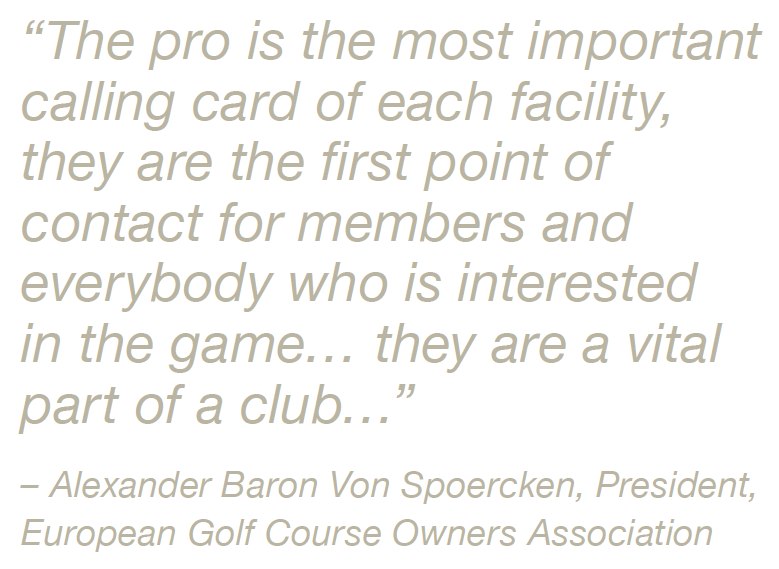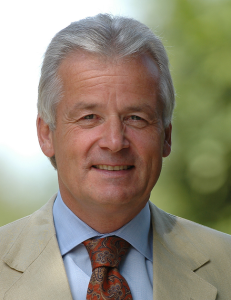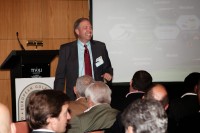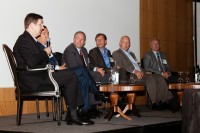Article by Aston Ward – PGA’s of Europe October 2013
Having taken office as the President of the European Golf Course Owners Association last year, Alexander Baron Von Spoercken is leading the organisation using his 25 years of experience in the industry. His beginning camefrom developing his own course in the North of Germany near Hamburg, and went on from there to develop, buy and sell other courses. His group today own and operate four golf courses in Germany. The EGCOA protects and nurtures the interests of owners and operators throughout Europe, from 9-hole facilities to the owners of multiple golf courses, and represents around 180 facilities and around 950 associated golf courses.
Something that is a key feature in the majority of those clubs is the PGA Professional. Here Alexander details why professionals are central to clubs and golf facilities, and how they should be aware of the changing trends to clubs as we move into the future…
In your time as an owner you will have worked with PGAs and many of their Professionals in a club environment – what in your mind as an owner is their role?
I’ve worked together with the PGA of Germany and I’ve always been a fan of the PGA and PGAs of Europe organisations and the training that is given to the pros. I think now we have to recognise, and I can talk specifically about Germany in this context, the role of the pro has changed during the last 25-30 years. I remember when we started off we had to pay our pros a retainer, a monthly fixed sum, and today the balance between supply and demand has shifted to such an extent that generally speaking the pros have to pay the facility that they are working at. So there’s been a major shift and we just have to recognise that and integrate it into the daily operations of a club.
First of all the game has changed and the consumer’s expectations have changed, and along with that the role of the golf professional is changing. There’s a move away from the ambition to learn to play golf really well and to play in tournaments, and become a good golfer – now the customer wants to have a good time nowadays away from a tournament as he has a tournament in his office everyday of the week! So there is a shift away from, for want of a better expression, ‘serious’ golf towards more ‘leisure’ golf, and I think we have to recognise that. So what does that mean for the golf professional? I think it means it’s important to continue their role as being the first port of call and point of contact for any aspiring golfer and anyone interested in golf.
They are the people that have the trust, and the person that needs to bring people into the game and then, something that is equally as important, keep them in the game. We have to make sure our professionals continue to be quality ‘professionals’. The game is turning into a sort of ‘entertainment’ like many other sports, which it wasn’t before. Before it was a serious sport, and for many their handicap was incredibly important to them, whereas now it is turning away slightly from that and becoming more a fun leisure activity – we have to make sure we keep the quality of the pros and not have the pros suddenly become entertainers – they need to balance entertainment/leisure with continuing to convey the spirit and essence of the sport.
What can the Professionals do to add value to the game? What is their key USP for an owner that makes it vital them to be at a club?
Well the pro is the most important calling card of each facility, they are the first point of contact for the members and everybody who is interested in the game, so they are a vital part in the club and in preparing the sale of memberships. The second part of their task is to play their role in the retention game, which is just as important as the selling game.
It is his or her relationship to the customer that is of the utmost importance – there is nobody else that the customer will get so close to and rely on as the professional. There is nobody in the club who is as competent as the pro, and nobody else who would spend so much time with a member who can advise them how to receive the most pleasure from the game, so it’s a crucial role that the pros play there.
There have undeniably been big changes in the role of the PGA Professional across a number of years. How do you think things might change further in the future?
We’re talking about trends in regard to all of these changes in the industry, and the changing role of the pro is just one of these trends that we have to recognise.
What’s becoming more and more important is the fact that time is of such dominance and relevance today – the professionals have to be able to bring across the advantages of golf much quicker than perhaps has been done in the past because nobody has the time they used to have to learn the sport.
So pros have to concentrate on bringing people into the game and on enjoying the sport as much as they can in a much shorter time. I think that means that questions that were important in the past like etiquette or rules and regulations, become less important because today’s golfer won’t enjoy it – his or her first ambition is not to bring down his handicap – it would be nice, but it’s not what they are looking for. These changes are less driven by the pro and more reactions to the changing market conditions, and this is what they should be aware of.
You are fairly new into the position of President of the EGCOA but have of course been involved for a long time before that. What do you think the EGCOA’s unique position and vision is?
It’s a great challenge, I think the EGCOA has a long way to go and there are many countries that we want to convince to become a member of the association because in these trying times I think together we can be stronger than everybody would be if they were out there on their own. We can share experiences, we can share knowledge, so I think the idea of creating an association, as well as the individual National Golf Course Owners Associations, is a good one and one that we need. I think we have to all work closely together, all the stakeholders in the industry should work together, and I think the formation of the national associations and European associations is a logical consequence of this need.
How do you see your area of the industry changing in the next in the next 20 years?
Generally speaking, facilities that are created today are done so for a commercial purpose, for a return on investment, which is different to the past. Previously things were not so much commercially and profit orientated. I think when new facilities come into the market there is a role that the EGCOA can fulfill in offering these facilities a representation and the national golf course federations we represent more of the traditional side of golf – I think there will be fewer traditional clubs and more profit-driven facilities.
The EGCOA will be the body that represents the interests of these new facilities and provides this exchange of knowledge and information. One very important factor, which is a little bit in contrast to existing clubs, is that we need to grow the customer base and we need to see to it that golf facilities are profitably run, otherwise there will be no growth and growth is exactly what we want. My focus would be on lowering the barriers because we know from market research that there are many people out there that are interested in golf that are kept out of the game because for some it’s too exclusive, too expensive, which is not accurate, golf doesn’t need to be exclusive nor expensive. We also need to keep the spirits and traditions of the game but we need to recognise that they will not play the role that they have done in the past.







